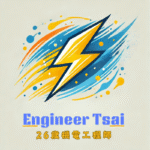The Story Behind Engineer Tsai
I did not start in an elite program. Instead, I learned on job sites.
Over time, I turned hard lessons into clear notes. As a result, I now teach electrical and MEP in a simple way.
In short, my goal is clarity, safety, and action.
What I believe
First, safety comes first. Second, diagrams and numbers beat jargon.
Finally, every lesson should end with a next step.

My Journey
At first, I traced wires and verified faults with a meter. Later, I noticed a gap: many guides were heavy on theory yet light on practice. Because of that, I began publishing short explainers and step-by-step tutorials. For instance, I cover panel labels, breaker choice, load math, and spec sheets. In addition, each idea maps to a safe action you can take tomorrow.
Over time, several outcomes stood out. First, study maps helped beginners pass entry-level tests without rote notes.
Next, long manuals became one-page checklists for panels and lighting.
Finally, power-and-cost calculators sped up decisions and, as a result, made them safer.
Above all, knowledge should never be a barrier to your dreams.
FAQ
Q1: I’m a beginner. Where should I start?
Start with the Basic Lessons series. Each post ends with a checklist and a next step so you don’t get stuck.
Q2: Do you teach code compliance?
I explain concepts and typical practices, then point to standards. Always follow local codes and your site’s rules.
Q3: Can I use your checklists at work?
Yes—download and adapt them. Add your site’s acceptance criteria and keep a change log.
Q4: What tools do I really need at home?
A reliable multimeter, non-contact tester, insulated screwdriver set, and a notebook for readings. Add a clamp meter if you log current.
Q5: How do you keep content accurate?
I include assumptions and references, test steps in the field where possible, and revise checklists based on reader feedback.
Join the Learning Community
Thousands of learners have improved their skills here—through articles, short videos, and eBooks that turn complex knowledge into clear, usable know-how.
